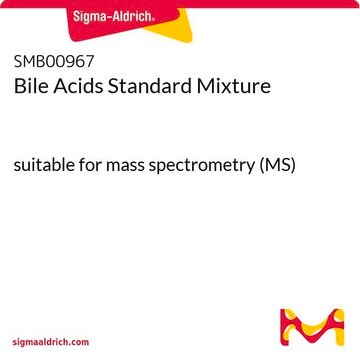MAK309
Bile Acid Assay Kit
sufficient for 100 fluorometric tests
Synonyme(s) :
Biliary Acid Quantification Kit, Total Bile Acids Assay Kit
Se connecterpour consulter vos tarifs contractuels et ceux de votre entreprise/organisme
About This Item
Code UNSPSC :
12161503
Nomenclature NACRES :
NA.84
Produits recommandés
Méthode de détection
fluorometric
Maladie(s) pertinente(s)
gastrointestinal diseases; cancer; cardiovascular diseases
Température de stockage
−20°C
Description générale
Twelve different types of bile acids are typically found in mammals, among them two primary types are cholic acid and chenodeoxycholic acid. These can be dehydroxylated into secondary bile acids. Finally, these four can be conjugated to either taurine or glycine creating 8 different conjugated bile acids. Bile acid levels in feces, blood, urine, and bile can be used as markers for various diseases such as hyperlipidemia, cholestasis, gall stones, colon cancer, etc. Bile acids also exist as sulfate salt forms known as bile acid sulfates. Sulfation of bile acids increases their solubility and decreases intestinal absorption, thereby enhancing fecal and urinary excretion.
Application
Bile Acid Assay Kit has been used to quantify bile acid levels from plasma.
Caractéristiques et avantages
Compatible with high-throughput handling systems.
Adéquation
Suitable for the quantitative determination of total bile acids and evaluation of drug effects on bile acid metabolism in serum, plasma, urine and other biological samples.
Principe
This Bile Acid Assay Kit provides a convenient fluorimetric means to measure total bile acids in biological samples. In the assay, 3–hydroxysteroid dehydrogenase reacts with all twelve bile acids, converting NAD to NADH, which reduces a probe to a highly fluorescent product. The resulting fluorescence intensity (γex = 530 nm/γem = 585 nm) is linear to the bile acid concentration in the sample.
Code de la classe de stockage
10 - Combustible liquids
Certificats d'analyse (COA)
Recherchez un Certificats d'analyse (COA) en saisissant le numéro de lot du produit. Les numéros de lot figurent sur l'étiquette du produit après les mots "Lot" ou "Batch".
Déjà en possession de ce produit ?
Retrouvez la documentation relative aux produits que vous avez récemment achetés dans la Bibliothèque de documents.
Les clients ont également consulté
Diagnosis of cirrhosis in patients with chronic hepatitis C genotype 4: Role of ABCB11 genotype polymorphism and plasma bile acid levels.
Besheer T, et al.
The Turkish Journal of Gastroenterology : The Official Journal of Turkish Society of Gastroenterology, 29, 299-307 (2018)
Bile acids: chemistry, physiology, and pathophysiology.
Monte M J, et al.
World Journal of Gastroenterology, 15(7), 804-804 (2009)
Tarek Besheer et al.
The Turkish journal of gastroenterology : the official journal of Turkish Society of Gastroenterology, 29(3), 299-307 (2018-05-15)
Chronic hepatitis C (CHC)-related mortality generally results from cirrhosis and subsequent complications. We aimed to investigate the potential role of plasma bile acid levels and ABCB11 1331T > C (V444A, rs2287622) (ATP-binding cassette subfamily B, member 11) gene polymorphism in
Hung Phuc Nguyen et al.
Journal of animal science, 98(12) (2020-11-18)
A 16-wk growth trial was conducted to examine the effects of dietary replacement of fish meal by defatted soybean meal (SBM) and fermented soybean meal (FSBM) with taurine supplementation on growth performance, nutrient apparent digestibility coefficient (ADC) and biological parameters
Bile acid transporters and regulatory nuclear receptors in the liver and beyond.
Halilbasic E, et al.
Journal of Hepatology, 58(1), 155-168 (2013)
Notre équipe de scientifiques dispose d'une expérience dans tous les secteurs de la recherche, notamment en sciences de la vie, science des matériaux, synthèse chimique, chromatographie, analyse et dans de nombreux autres domaines..
Contacter notre Service technique











